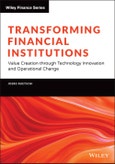Transform your financial organisation’s formula for value creation with this insightful and strategic approach
In Transforming Financial Institutions through Technology Innovation and Operational Change, visionary turnaround leader Joerg Ruetschi delivers a practical and globally relevant methodology and framework for value creation at financial institutions. The author demonstrates how financial organisations can combine finance strategy with asset-liability and technology management to differentiate their services and gain competitive advantage in a ferocious industry.
In addition to exploring the four critical areas of strategic and competitive transformation - financial analysis, valuation, modeling, and stress - the book includes:
- Explanations of how to apply the managerial fundamentals discussed in the book in the real world, with descriptions of the principles for reorganization, wind-down and overall value creation
- An analysis of the four key emerging technologies in the financial industry: AI, blockchain, software, and infrastructure solutions, and their transformational impact
- Real-world case studies and examples on how financial institutions can be repositioned and rebuilt on a path of profitability
Perfect for managers and decision makers in the financial services industry, Transforming Financial Institutions through Technology Innovation and Operational Change is also required reading for regulators, tech firms, and private equity and venture capital funds.
Table of Contents
About the Author xi
Introduction 1
Part One Managerial Fundamentals
Chapter 1 Strategic Decision Making 7
1.1 Strategic analysis 7
1.1.1 Hypothesis-driven problem solving 8
1.1.2 System theory 12
1.1.3 Coherence 13
1.2 Strategic planning 17
1.2.1 Roadmap 17
1.2.2 Impact assessment 17
1.2.3 Strategic options and portfolio choices 20
1.2.4 Action and response plan 21
1.3 Operational excellence 23
1.3.1 Operating model 23
1.3.2 Balance scorecard 24
1.3.3 Best practice and benchmarking 26
1.4 Business performance improvement 26
1.4.1 Portfolio optimisation 27
1.4.2 Divestments and disposals 28
1.4.3 Front-to-back optimisation 28
1.4.4 Cost reduction 29
1.4.5 Technology replatforming 31
1.5 Merger and acquisition 32
Chapter 2 Financial Decision Making 35
2.1 Financial analysis 35
2.1.1 Financial statements 35
2.1.2 Financial ratios 44
2.1.3 Leverage analysis 46
2.2 Financial valuation 47
2.2.1 Valuation methods and principles 48
2.2.2 Valuation models and techniques 53
2.3 Financial modelling 61
2.3.1 Risk and return 61
2.3.2 Asset pricing 68
2.3.3 Contingent claims 74
2.4 Financial stress 86
2.4.1 The cycle of financial stress 86
2.4.2 Liquidity risk 88
2.4.3 Market dislocations 90
2.4.4 Systemic crises 96
Chapter 3 Asset-liability Management 101
3.1 Risk transfer 101
3.1.1 Principles of risk-taking 101
3.1.2 The pricing taxonomy of risk 102
3.2 Financial engineering 116
3.2.1 Cash instruments 117
3.2.2 Forwards and futures 120
3.2.3 Swaps 124
3.2.4 Options 132
3.2.5 Securitisation 138
3.3 Risk management 141
3.3.1 Enterprise-wide risk management 142
3.3.2 Value-at-risk 143
3.4 Capital management 145
3.4.1 Capital adequacy 145
3.4.2 Capital structure 145
3.4.3 Funding mix 147
3.4.4 Capital allocation mechanism 148
3.5 The Basel framework 149
3.5.1 Historical context and development 149
3.5.2 Methodological framework 150
3.5.3 Regulatory capital 151
3.5.4 Risk-weighted assets 154
3.5.5 Liquidity requirements 161
3.5.6 Additional regulatory considerations of the G20 reform 163
Chapter 4 Technology Management and Innovation 165
4.1 Financial technology management 166
4.1.1 Traditional role and innovation 166
4.1.2 Targeted replatforming 167
4.2 Emerging technologies 168
4.2.1 Software and infrastructure 169
4.2.2 Artificial intelligence 173
4.2.3 Distributed ledger technology 177
4.3 The transformational impact of financial technology 182
4.3.1 Operational efficiency 182
4.3.2 Augmented decision making 189
4.3.3 Digital financial innovation 193
Part Two Repositioning Financial Institutions
Chapter 5 Turnaround and Transformation 203
5.1 Reorganisation and wind-down 204
5.1.1 Legal principles 205
5.1.2 Reorganisation and wind-down of financial institutions 212
5.2 Turnaround process 217
5.2.1 Crisis management 217
5.2.2 Turnaround plan 220
5.2.3 Financial restructuring 223
5.2.4 Operational restructuring 228
Chapter 6 Value Creation and Growth 231
6.1 Intrinsic value 231
6.1.1 Growth initiatives 232
6.1.2 High-impact situations and the M&A transaction life cycle 233
6.1.3 Value creation plan 241
6.2 Value optimisation 244
6.2.1 Commercial optimisation 244
6.2.2 Operational optimisation 246
6.2.3 Financial optimisation 247
6.3 Value realisation 248
6.3.1 Governance and central programme management 248
6.3.2 Operational blueprint 250
6.3.3 Targeted implementation 254
Part Three Conclusion
Chapter 7 Rebuilding the Global Banking Industry 259
7.1 The industry’s change and growth agenda 259
7.2 The transformational impact of technology 261
7.3 Specialisation and inclusive risk transfer 262
Afterword and Acknowledgment 265
Bibliography 269
Index 275








